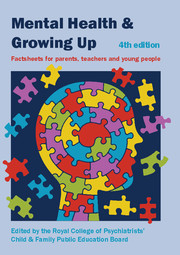Book contents
- Frontmatter
- Contents
- Contributors
- Factsheets for young people
- Factsheets for parents, carers and anyone who works with young people
- 1 Good parenting
- 2 The restless and excitable child
- 3 Dealing with tantrums
- 4 Children who soil or wet themselves
- 5 Sleep problems in childhood and adolescence
- 6 Behavioural problems and conduct disorder
- 7 Attention-deficit hyperactivity disorder (ADHD)
- 8 The child with general learning disability
- 9 Specific learning difficulties
- 10 Autism and Asperger syndrome
- 11 Depression in children
- 12 Worries and anxieties: helping children to cope
- 13 Divorce or separation of parents: the impact on children and adolescents
- 14 Death in the family: helping children to cope
- 15 The emotional cost of bullying
- 16 Traumatic stress in children
- 17 Domestic violence: its effects on children
- 18 Child abuse and neglect: the emotional effect
- 19 Drugs and alcohol: what parents need to know
- 20 Self-harm in young people
- 21 Psychosis
- 22 Schizophrenia
- 23 Bipolar disorder in children and adolescents
- 24 Obsessive–compulsive disorder in children and young people
- 25 Eating disorders in young people
- 26 Chronic physical illness: the effects on mental health
- 27 Medically unexplained physical symptoms
- 28 Chronic fatigue syndrome: helping your child get better
- 29 Parental mental illness: the problems for children
- 30 Who's who in CAMHS
17 - Domestic violence: its effects on children
from Factsheets for parents, carers and anyone who works with young people
Published online by Cambridge University Press: 02 January 2018
- Frontmatter
- Contents
- Contributors
- Factsheets for young people
- Factsheets for parents, carers and anyone who works with young people
- 1 Good parenting
- 2 The restless and excitable child
- 3 Dealing with tantrums
- 4 Children who soil or wet themselves
- 5 Sleep problems in childhood and adolescence
- 6 Behavioural problems and conduct disorder
- 7 Attention-deficit hyperactivity disorder (ADHD)
- 8 The child with general learning disability
- 9 Specific learning difficulties
- 10 Autism and Asperger syndrome
- 11 Depression in children
- 12 Worries and anxieties: helping children to cope
- 13 Divorce or separation of parents: the impact on children and adolescents
- 14 Death in the family: helping children to cope
- 15 The emotional cost of bullying
- 16 Traumatic stress in children
- 17 Domestic violence: its effects on children
- 18 Child abuse and neglect: the emotional effect
- 19 Drugs and alcohol: what parents need to know
- 20 Self-harm in young people
- 21 Psychosis
- 22 Schizophrenia
- 23 Bipolar disorder in children and adolescents
- 24 Obsessive–compulsive disorder in children and young people
- 25 Eating disorders in young people
- 26 Chronic physical illness: the effects on mental health
- 27 Medically unexplained physical symptoms
- 28 Chronic fatigue syndrome: helping your child get better
- 29 Parental mental illness: the problems for children
- 30 Who's who in CAMHS
Summary
Who are the abusers and victims?
Although a man abusing a woman is recognised more often, the adults may be of either gender or any sexuality. It can happen among people of any class, religion, race, occupation or age.
It is common thinking that alcohol and mental illness can cause a person to be violent. Alcohol does not cause domestic violence, but there is evidence that where domestic violence exists, alcohol is often present. Most people who are mentally ill are not violent.
Anyone can be a victim of domestic violence. Children, even pets, can be affected. People with mental illness are more likely to be the victims of violence than perpetrators of violence.
How are children involved?
In relationships where there is domestic violence, children witness about three-quarters of the abusive incidents. About half the children in these families have themselves been badly hit or beaten. Sexual and emotional abuse is also more likely to happen in these families.
How are children affected?
It is very upsetting for children to see one of their parents (or carers) abusing or attacking the other. They often show signs of great distress.
• Younger children may become anxious. They can complain of tummy aches or start to wet their bed. They may find it difficult to sleep, have temper tantrums and start to behave as if they are much younger than they are.
• Older children react differently. Boys seem to express their distress much more outwardly. They may become aggressive and disobedient. Sometimes, they start to use violence like bullying to try and solve problems, and may copy the behaviour they see within the family. Older boys may play truant and start to use alcohol or drugs.
• Girls are more likely to keep their distress inside. They may become withdrawn from other people, and become anxious or depressed. They may think badly of themselves and complain of vague physical symptoms. They are more likely to have an eating disorder or to harm themselves by taking overdoses or cutting themselves.
• Children with these problems often do badly at school. They may refuse to go to school. They may also get symptoms of post-traumatic stress disorder, for example, have nightmares and flashbacks, and be easily startled.
- Type
- Chapter
- Information
- Mental Health and Growing UpFactsheets for Parents, Teachers and Young People, pp. 96 - 98Publisher: Royal College of PsychiatristsPrint publication year: 2013



